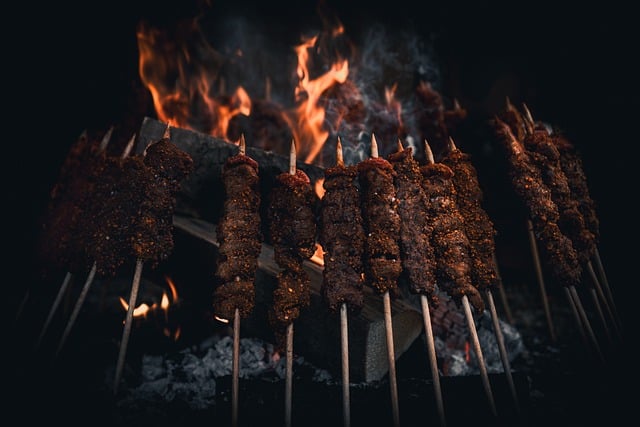Savoring the Smokehouse: Secrets of Low and Slow BBQ Mastery
Embark on a mouthwatering journey into the world of low and slow barbecue, where patience and precision transform humble cuts of meat into succulent masterpieces. From choosing the right wood to perfecting your smoke ring, this guide unveils the art and science behind creating unforgettable BBQ flavors that will elevate your outdoor cooking game to new heights.

Choosing Your Smoker
Selecting the right smoker is crucial for mastering low and slow BBQ. There are several types to choose from, each with its own advantages:
-
Offset Smokers: These traditional “stick burners” offer excellent temperature control and authentic smoky flavor.
-
Pellet Smokers: Known for their convenience and consistent temperatures, pellet smokers are perfect for beginners.
-
Kamado Grills: These versatile ceramic cookers excel at maintaining low temperatures for extended periods.
-
Electric Smokers: Ideal for urban dwellers, electric smokers provide set-it-and-forget-it convenience.
-
Water Smokers: These affordable options use water to help regulate temperature and add moisture to the cooking environment.
Consider factors like fuel type, capacity, and ease of use when choosing your smoker. Remember, the best smoker is the one you’ll use most often.
The Art of Wood Selection
Wood selection is a crucial aspect of low and slow BBQ, as it significantly influences the final flavor profile of your meat. Different woods impart unique tastes and aromas:
-
Hickory: A classic choice, offering a strong, bacon-like flavor perfect for pork and beef.
-
Apple: Provides a mild, sweet smoke ideal for poultry and pork.
-
Mesquite: Delivers an intense, earthy flavor that pairs well with beef and game meats.
-
Oak: A versatile wood with a medium smoke flavor suitable for most meats.
-
Cherry: Imparts a mild, fruity sweetness that complements poultry and pork.
Experiment with wood combinations to create your signature flavor profile. Start with milder woods and gradually introduce stronger ones to avoid overpowering the meat’s natural taste.
Mastering Temperature Control
Maintaining a consistent temperature is the cornerstone of successful low and slow BBQ. Here are some tips to help you achieve temperature mastery:
-
Use a reliable thermometer: Invest in a high-quality digital thermometer to monitor both the smoker and meat temperatures accurately.
-
Create heat zones: Arrange your coals or burners to create different temperature zones within your smoker.
-
Utilize water pans: Adding a water pan helps stabilize temperature and adds moisture to the cooking environment.
-
Learn vent control: Adjust the intake and exhaust vents to fine-tune airflow and temperature.
-
Practice patience: Resist the urge to constantly open the smoker, as this causes temperature fluctuations.
Remember, consistency is key. Small temperature swings are normal, but aim to keep your smoker within 10-15 degrees of your target temperature.
Perfecting the Smoke Ring
The coveted smoke ring is the hallmark of great barbecue. This pink layer just beneath the surface of the meat is formed when nitrogen dioxide from wood smoke interacts with myoglobin in the meat. To achieve the perfect smoke ring:
-
Start with cold meat: Refrigerated meat absorbs smoke more readily.
-
Use the right wood: Hardwoods like hickory and oak produce more nitrogen dioxide.
-
Maintain proper airflow: Ensure good ventilation to keep the smoke clean and flowing.
-
Keep the meat moist: Spritz with apple juice or water periodically to enhance smoke absorption.
-
Don’t oversmoke: Too much smoke can lead to bitter flavors and an unappetizing appearance.
While a smoke ring doesn’t necessarily indicate better flavor, it’s a visual testament to your BBQ skills and adds to the overall appeal of your smoked meats.
BBQ Pro Tips and Facts
• The “stall” is a natural phenomenon where meat temperature plateaus during cooking. Patience is key; the temperature will eventually rise again.
• Wrapping meat in foil (the “Texas Crutch”) can help push through the stall faster but may soften the bark.
• Spritzing meat with liquid every hour can help prevent it from drying out and enhance smoke flavor.
• Resting meat after cooking allows juices to redistribute, resulting in a more tender and flavorful bite.
• The term “bark” refers to the flavorful, crispy exterior that forms on smoked meats.
• Different meats have different ideal internal temperatures: brisket (195-205°F), pork shoulder (195-205°F), ribs (190-203°F).
• Using a water pan in your smoker can help regulate temperature and add moisture to the cooking environment.
Low and slow BBQ is a rewarding culinary adventure that combines science, art, and patience. By mastering temperature control, wood selection, and smoking techniques, you’ll be well on your way to creating mouthwatering barbecue that will impress friends and family. Remember, practice makes perfect, so fire up that smoker and start your journey towards BBQ mastery. With time and experience, you’ll develop your own signature style and flavors that will have everyone coming back for seconds.





